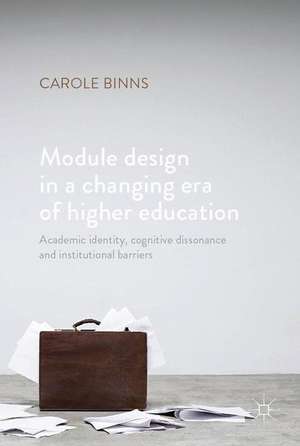Module Design in a Changing Era of Higher Education: Academic Identity, Cognitive Dissonance and Institutional Barriers
Autor Carole Binnsen Limba Engleză Hardback – 11 aug 2017
Preț: 698.15 lei
Preț vechi: 821.35 lei
-15% Nou
Puncte Express: 1047
Preț estimativ în valută:
133.63€ • 145.20$ • 112.32£
133.63€ • 145.20$ • 112.32£
Carte tipărită la comandă
Livrare economică 19 aprilie-03 mai
Preluare comenzi: 021 569.72.76
Specificații
ISBN-13: 9781137553690
ISBN-10: 1137553693
Pagini: 240
Ilustrații: X, 242 p.
Dimensiuni: 148 x 210 x 20 mm
Greutate: 0.45 kg
Ediția:1st ed. 2017
Editura: Palgrave Macmillan UK
Colecția Palgrave Macmillan
Locul publicării:London, United Kingdom
ISBN-10: 1137553693
Pagini: 240
Ilustrații: X, 242 p.
Dimensiuni: 148 x 210 x 20 mm
Greutate: 0.45 kg
Ediția:1st ed. 2017
Editura: Palgrave Macmillan UK
Colecția Palgrave Macmillan
Locul publicării:London, United Kingdom
Cuprins
PART I. Overview and Contextualisation.- Chapter 1. Introduction.- Chapter 2. The Changing Era of Higher Education.- PART II. Practice and Design.- Chapter 3. What is Module Design?.- Chapter 4. The Role of a Module Designer.- PART III. Real World Experiences: The Practice and Process of Module Design as an Experience.- Chapter 5. Theoretical Insights and Collecting the Data.- Chapter 6. The Experiences of Module Design in One UK University.- Chapter 7. The Practice and Process of Module Design as an Experience Part I: Pressures, Constraints and the Assessment.- Chapter 8. The Practice and Process of Module Design as an Experience Part II: The Impact of Working Relationships on the Practice and Process of Design.- Chapter 9. The Practice and Process of Module Design as an Experience Part III: Paperwork, Administration and Training.- Chapter 10. Conclusion: A New Culture of Module Design.
Notă biografică
Carole Binns is Lecturer in Criminal Justice Studies in the Faculty of Social Sciences at the University of Bradford, UK.
Textul de pe ultima copertă
This book explores the module design experiences and practices of academics employed within one UK university, and during a period of social and economic change in which university staff are designing and delivering curricula for changing student populations, with different profiles and expectations than previous generations. The book raises issues such as why, in a climate of reduced resources, staff increase their own workloads by re-writing lectures to accommodate changing student needs, and how institutional practices that are used to encourage curriculum innovation are often having a perceived opposite effect. It will appeal to academic staff, students of higher education studies, and policy-makers within the education sector.
Caracteristici
Critically examines how university modules are designed and redesigned for changing student populations Explores how academic staff approach the task of module design/redesign ‘in real life’ as opposed to the ideal processes which are often set out in the leading texts on educational development Suggests important implications for academic staff and educational developers across all subject areas Includes supplementary material: sn.pub/extras











